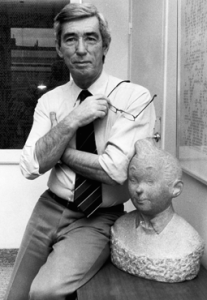Iftikar Ahmed
Georges Prosper Remi, known by the pen name Hergé was born Today. The man created one of his most endearing characters i.e., Tintin.

Courtesy : Wiki
In the early 1930s, Father Gosset a Catholic priest, who was living and working as the chaplain of Chinese students at the University of Leuven, intrigued by Georges Remi’s upcoming Tintin adventure set in China, suggested that he seek the perspective of a young Chinese artist named Zhang Chongren. Zhang, a student at the prestigious Académie Royale des Beaux-Arts, was renowned for his deep understanding of China and its people.
The fateful meeting between Georges Remi, known by his pen name Herge, and Zhang Chongren blossomed into a profound friendship. Inspired by Zhang’s insights, Herge contemplated giving him a co-writing credit for their collaboration on “Tintin and the Blue Lotus.” This particular instalment, released in 1934, is widely regarded as Herge’s most vehement critique of imperialism and the Japanese conquest of China.
Unlike Herge’s previous works, which sometimes portrayed simplistic and stereotypical depictions of Africans and American gangsters, “Tintin and the Blue Lotus” challenged the prevailing narratives. It delved into the dark underbelly of imperialism, exposing the atrocities committed by the Japanese in China. Immortalized within the pages of the adventure was Zhang himself, transformed into Chang Chong-Chen, a young Chinese orphan who provided unwavering support to Tintin throughout his arduous journey.
The release of “Tintin and the Blue Lotus” caused a stir that extended beyond the pages of the comic book. Japanese diplomats stationed in Belgium lodged an official complaint and even threatened to take the matter to the Court of International Justice at The Hague. Yet, the resulting publicity only served to fuel the book’s popularity, captivating an even wider audience.
Zhang returned to his homeland, China, in 1943. Unfortunately, he faced the harsh realities of the cultural revolution and was compelled to work as a sweeper. However, with Mao’s demise in the late seventies, Zhang’s status as a prominent artist was eventually restored. His resilient spirit endured, and his artistic endeavors thrived once more.
While Herge fondly remembered his dear friend Chang, he had the chance to reunite with Zhang in 1981. Their meeting, long overdue, brought joy and nostalgia to both men. Zhang, now a French citizen since 1989, settled in France, where he forged a formidable reputation as an artist and sculptor. His remarkable talent captured the essence of various subjects, including a notable portrayal of French President Mitterand.
However, it is as the young Chinese boy and unwavering friend of the world-famous reporter Tintin that Zhang Chongren will forever be immortalised. His contributions to “Tintin and the Blue Lotus” were instrumental in shaping one of Herge’s most impactful and thought-provoking adventures. The enduring legacy of their collaboration stands as a testament to the power of friendship and the ability of art to challenge prevailing narratives and inspire change.
It's the birth anniversary of Herge, the man who created Tintin. And this story is about one of his most endearing characters.
It was in the early 30s that a certain Father Gosset heard that Georges Remi's next serialized Tintin story would be about China. pic.twitter.com/IswHsHqlaT— Joy Bhattacharjya (@joybhattacharj) May 22, 2023





